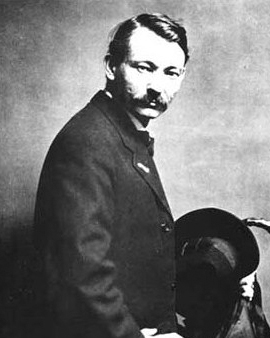First of all, some irritations with the American painter Robert Henri due to his name have to be cleared up. Robert Earle Henri and Robert Henry Cozad are two names for one and the same person. The painter was born Robert Henry Cozad, but like his entire family, he changed his identity due to a fatal incident involving his father. Henri underwent a classical European education after his training at the Pennsylvania Academy of Fine Arts. He left the USA to study in France and continued his education in Italy and Great Britain. During his time in Paris, the paintings of Francois Millet and the expressions of Impressionism had a special influence. After the end of his European educational stay, Henri moved to the Philadelphia School of Design for Women as a lecturer.
The experiences with dynamic modernism in the US cities changed Henri's artistic perspective. The forms of expression and subjects of Impressionism increasingly appeared to be inadequate for depicting the reality of the modern metropolis. Henri was looking for new, unspent motifs in his modern American environment and for a new kind of formal language. He shared this search with a number of other American artists with whom he was in exchange, such as William Glackens, George Luks, Everett Shinn and John Sloan. Together with these painters, Henri stands for the Ashcan School and its dedication to a relentless reflection of big-city reality.
Henri was at the centre of the artistic debate with the conservative artistic mainstream in the USA. In 1908 Henri was one of the organizers of an exhibition entitled "The Eight", which aimed to make a statement against the prevailing taste in art in museums and galleries. Henri was also one of the eight modern painters exhibited there. In 1913, together with the Eight, they accompanied the Armory Show, the aim of which was to bring European modernist painters to the attention of a larger public in the USA. However, the works of Cubism and Futurism exhibited there were an artistic challenge for the convinced realist Henri. The rebel against the art mainstream and the art establishment now became part of the mainstream himself. In 1929 the Art Council of New York declared Henri one of the three most important living painters in the USA. After his death, Henri was honored with a commemorative exhibition at the Metropolitan Museum.
×





.jpg)
.jpg)
.jpg)
.jpg)
_-_(MeisterDrucke-1645439).jpg)
_-_(MeisterDrucke-1645439).jpg)
.jpg)
.jpg)
.jpg)
.jpg)
.jpg)
.jpg)
.jpg)
.jpg)
.jpg)
.jpg)
_-_(MeisterDrucke-1449090).jpg)
_-_(MeisterDrucke-1449090).jpg)
_1902_-_(MeisterDrucke-383140).jpg)
_1902_-_(MeisterDrucke-383140).jpg)
.jpg)
.jpg)
_-_(MeisterDrucke-1452602).jpg)
_-_(MeisterDrucke-1452602).jpg)
.jpg)
.jpg)
_-_(MeisterDrucke-1126108).jpg)
_-_(MeisterDrucke-1126108).jpg)
.jpg)
.jpg)
.jpg)
.jpg)
.jpg)
.jpg)
.jpg)
.jpg)
.jpg)
.jpg)
_-_(MeisterDrucke-1529014).jpg)
_-_(MeisterDrucke-1529014).jpg)
.jpg)
.jpg)
.jpg)
.jpg)
.jpg)
.jpg)
.jpg)
.jpg)
_1922_-_(MeisterDrucke-149997).jpg)
_1922_-_(MeisterDrucke-149997).jpg)
.jpg)
.jpg)
.jpg)
.jpg)
.jpg)
.jpg)
.jpg)
.jpg)
.jpg)
.jpg)
 - (MeisterDrucke-12165).jpg)
 - (MeisterDrucke-12165).jpg)
.jpg)
.jpg)
.jpg)
.jpg)
.jpg)
.jpg)
.jpg)
.jpg)
.jpg)
.jpg)
.jpg)
.jpg)
_-_(MeisterDrucke-1126092).jpg)
_-_(MeisterDrucke-1126092).jpg)
.jpg)
.jpg)
.jpg)
.jpg)
.jpg)
.jpg)
.jpg)
.jpg)
.jpg)
.jpg)
.jpg)
.jpg)
_1912_-_(MeisterDrucke-313228).jpg)
_1912_-_(MeisterDrucke-313228).jpg)
.jpg)
.jpg)
_(oil_on_canvas)_-_(MeisterDrucke-1448424).jpg)
_(oil_on_canvas)_-_(MeisterDrucke-1448424).jpg)
_1911_(Oil_on_canvas)_-_(MeisterDrucke-1490252).jpg)
_1911_(Oil_on_canvas)_-_(MeisterDrucke-1490252).jpg)
.jpg)
.jpg)
.jpg)
.jpg)
 - (MeisterDrucke-669012).jpg)
 - (MeisterDrucke-669012).jpg)
.jpg)
.jpg)
 - (MeisterDrucke-12162).jpg)
 - (MeisterDrucke-12162).jpg)
.jpg)
.jpg)
.jpg)
.jpg)
.jpg)
.jpg)
.jpg)
.jpg)
.jpg)
.jpg)
.jpg)
.jpg)
.jpg)
.jpg)
.jpg)
.jpg)
.jpg)
.jpg)
_-_(MeisterDrucke-1126126).jpg)
_-_(MeisterDrucke-1126126).jpg)
.jpg)
.jpg)
.jpg)
.jpg)
.jpg)
.jpg)
.jpg)
.jpg)
.jpg)
.jpg)
.jpg)
.jpg)
.jpg)
.jpg)
.jpg)
.jpg)
.jpg)
.jpg)
.jpg)
.jpg)
.jpg)
.jpg)
.jpg)
.jpg)
.jpg)
.jpg)
.jpg)
.jpg)
.jpg)
.jpg)
.jpg)
.jpg)
.jpg)
.jpg)
.jpg)
.jpg)
.jpg)
.jpg)
.jpg)
.jpg)
 - (MeisterDrucke-599064).jpg)
 - (MeisterDrucke-599064).jpg)
.jpg)
.jpg)
.jpg)
.jpg)
.jpg)
.jpg)
.jpg)
.jpg)
.jpg)
.jpg)
.jpg)
.jpg)
.jpg)
.jpg)
.jpg)
.jpg)
.jpg)
.jpg)
.jpg)
.jpg)






